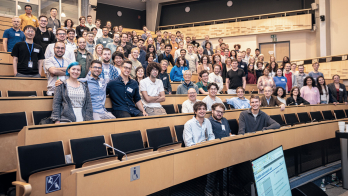
A large discrepancy in nuclear decay rates spotted four years ago in an experiment in Hungary has received new experimental support, generating media headlines about the possible existence of a fifth force of nature.
In 2015, researchers at the Institute of Nuclear Research (“Atomki”) in Debrecen, Hungary, reported a large excess in the angular distribution of e+e– pairs created during nuclear transitions of excited 8Be nuclei to their ground state (8Be* → 8Be γ; γ → e+e–). Significant peak-like enhancement was observed at large angles measured between the e+e– pairs, corresponding to a 6.8σ surplus over the expected e+e– pair-creation from known processes. The excess was soon interpreted by theorists as being due to the possible emission of a new boson X with a mass of 16.7 MeV decaying into e+e– pairs.
In a preprint published in October 2019, the Atomki team has now reported a similar excess of events from the electromagnetically forbidden “M0” transition in 4He nuclei. The anomaly has a statistical significance of 7.2σ and is likely, claim the authors, to be due to the same “X17” particle proposed to explain the earlier 8Be excess.
Quality control
“We were all very happy when we saw this,” says lead author Attila Krasznahorkay. “After the analysis of the data a really significant effect could be observed.” Although not a fully blinded analysis, Krasznahorkay says the team has taken several precautions against bias and carried out numerous cross- checks of its result. These include checks for the effect in the angular correlation of e+e– pairs in different regions of the energy distribution, and assuming different beam and target positions. The paper does not go into the details of systematic errors, for instance due to possible nuclear-modeling uncertainties, but Krasznahorkay says that, overall, the result is in “full agreement” with the results of the Monte Carlo simulations performed for the X17 decay.

While it cannot yet be ruled out, the existence of an X boson is not naively expected, say theorists. For one, such a particle would have to “know” about the distinction between up and down quarks and thus electroweak symmetry breaking. Being a vector boson, the X17 would constitute a new force. It could also be related to the dark-matter problem, write Krasznahorkay and co-workers, and could help resolve the discrepancy between measured and predicted values of the muon magnetic moment.
Last year, the NA64 collaboration at CERN reported results from a direct search for the X boson via the bremsstrahlung reaction eZ → eZX, the absence of a signal placing the first exclusion limits on the X–e– coupling in the range (1.3–4.2) × 10–4. “The Atomki anomaly could be an experimental effect, a nuclear-physics e ect or something completely new,” comments NA64 spokesperson Sergei Gninenko. “Our results so far exclude only a fraction of the allowed parameter space for the X boson, so I’m really interested in seeing how this story, which is only just beginning, will unfold.” Last year, researchers used data from the BESIII experiment in China to search for direct X-boson production in electron–positron collisions and indirect production in J/ψ decays – finding no signal. Krasznahorkay and colleagues also point to the potential of beam-dump experiments such as PADME in Frascati, and to the upcoming Dark Light experiment at Jefferson Laboratory, which will search for 10–100 MeV dark photons.
I do not know of any inconsistencies in the experimental data that would indicate that it is an experimental effect
Jonathan Feng
Theorist Jonathan Feng of the University of California at Irvine, who’s group proposed the X-boson hypothesis in 2016, says that the new 4He results from Atomki support the previous 8Be evidence of a new particle – particularly since the excess is observed at a slightly different e+e– opening angle in 4He (115o) than it is in 8Be (135o). “If it is an experimental error or some nuclear-physics effect, there is no reason for the excess to shift to different angles, but if it is a new particle, this is exactly what is expected,” says Feng. “I do not know of any inconsistencies in the experimental data that would indicate that it is an experimental effect.”
Data details
In 2017, theorists Gerald Miller at the University of Washington and Xilin Zhang at Ohio State concluded that, if the Atomki data are correct, the original 8Be excess cannot be explained by nuclear-physics modelling uncertainties. But they also wrote that a direct comparison to the e+e– data is not feasible due to “missing public information” about the experimental detector efficiency. “Tuning the normalisation of our results reduces the confidence level of the anomaly by at least one standard deviation,” says Miller. As for the latest Atomki result, the nuclear physics in 4He is more complicated than 8Be because two nuclear levels are involved, explains Miller, making it difficult to carry out an analysis analogous to the 8Be one. “For 4He there is also a background pair- production mechanism and interference effect that is not mentioned in the paper, much of which is devoted to the theory and other future experiments,” he says. “I think the authors would have been better served if they presented a fuller account of their data because, ultimately, this is an experimental issue. Confirming or refuting this discovery by future nuclear experiments would be extremely important. A monumental discovery could be possible.”
A monumental discovery could be possible
Gerald Miller
The Hungarian team is now planning on repeating the measurement with a new gamma-ray coincidence spectrometer at Atomki (see main image), which they say might help to distinguish between the vector and the pseudoscalar interpretation of the X17. Meanwhile, a project called New JEDI will enable an independent veri cation of the 8Be anomaly at the ARAMIS-SCALP facility (Orsay, France) during 2020, followed by direct searches by the same group for the existence of the X boson, in particular in other light quantum systems, at the GANIL-SPIRAL2 facility in Caen, France.
“Many people are sceptical that this is a new particle,” says Feng, who too was doubtful at first. “But at this point, what we need are new ideas about what can cause this anomaly. The Atomki group has now found the effect in two different decays. It would be most helpful for other groups to step forward to confirm or refute their results.”








